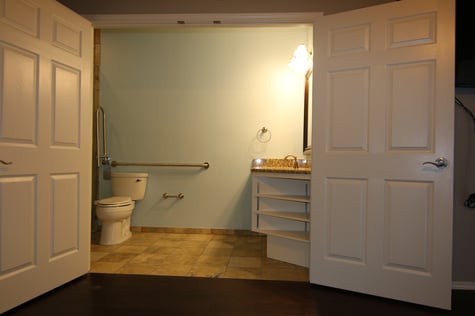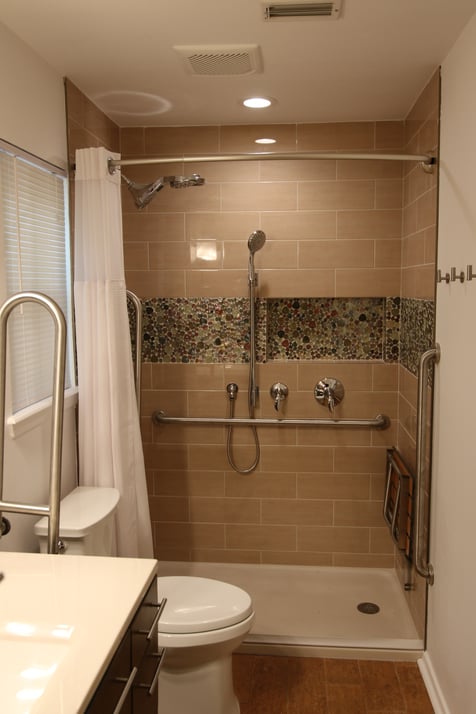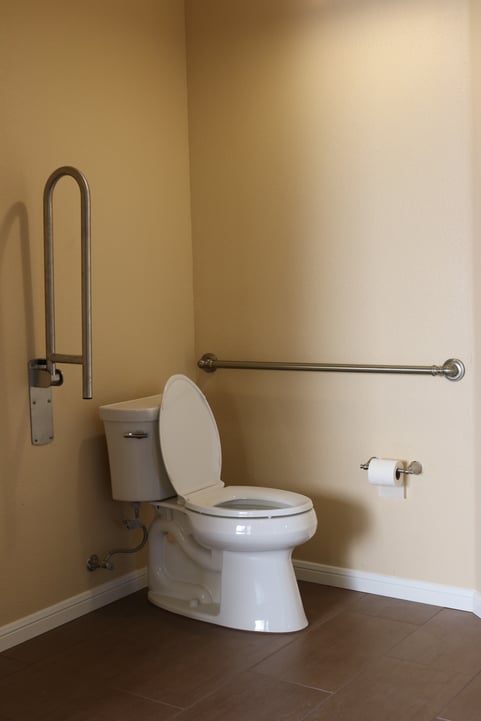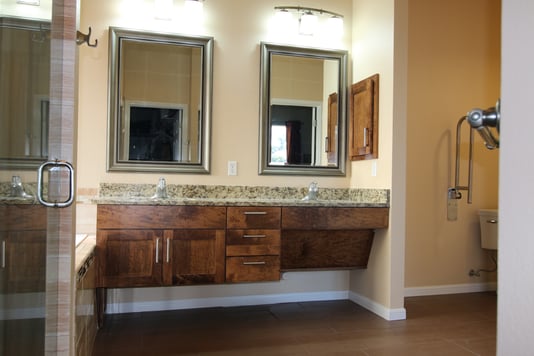As a universal design/build construction company located in Austin, Texas, T-Square Company realizes that building for your future changing needs is a very valuable consideration concerning all your periodic remodeling projects. We always design for the future for our clients, regardless of their age or abilities. This thought process is especially true when designing a bathroom upgrade. Being a nationally CAPS certified remodeler, we are very aware your personal needs can change in the blink of an eye. The daily tasks of getting into the bathroom, bathing, showering, using the toilet, or brushing your teeth can become almost impossible without assistance if you don't address your bathroom's inaccessibility in a proactive manner. Any revisions must be completed before you absolutely need the help. Design shortcomings become ever so noticeable if you have an accident and are recovering at home or a debilitating disease sets in. Most all problems caused by architectural barriers will be eliminated with a handicap accessible bathroom remodel.
We are certain that avoiding emergency remodeling while incorporating Universal Design techniques into your home whenever possible is a great way of enhancing your health, independence, and safety. This practice also provides a better overall quality of life. The sooner the main inaccessible areas in your home are addressed, the longer you and your family have to enjoy them. For those desiring to Age in Place, as in safely living in your own home for as long as possible, gradually incorporating the principles of Universal Design into all remodeling projects provides a seamless gateway for successful aging. So, what are the main concerns when designing a bathroom for the future?
Getting Into The Bathroom

When possible, you should always install a 36-inch wide door into your bathroom allowing all mobility devices to enter without obstruction. Sometimes it's easier when walls cannot be altered or removed to make a large double door entry into the bathroom. Replacing the original twenty-four to twenty-eight-inch wide door offers maximum accessibility for anyone. This universal design element provides clear approaches toward all bathroom fixtures from an adjoining room. Additionally, an unobstructed 60-inch wheelchair turning radius is shared by the bathroom and adjacent room.
An Accessible Shower

A safe, low-profile (1 1/2" tall) accessible shower with roll-in capability from an add-on ramp suits the needs of most diverse homeowners. Even if you don't require the grab bars during a particular phase of your life, installing adequate blocking before the tile is installed provides a universal path for your future needs once the bars are required. Take note, the grab bars must be able to withstand a shear force of 300 pounds. Their purpose is to provide support and stability when you need it most. Clutter within the shower and especially on the shower floor is a safety hazard. Recessed shampoo niches keep shampoo bottles and other items off the floor. Additionally, folding shower seats are far safer than free-standing models that are rarely ever in the right place. They save space when folded while not in use and never interrupt the use of a shower chair. It is a common misconception that shower controls must be mounted on one wall underneath the fixed shower head. Shower valves can be installed anywhere they are most convenient for the user, especially if a caretaker is involved. A recessed shower can light above the shower decreases shadows and further increases safety.
Using The Toilet

When a toilet exists in a confining room or space, there is no easy way of approaching it if you have mobility problems and especially if you are using any kind of mobility device. After all, safety is the predominant concern when using the toilet. Remove all restricting walls and narrow doors so everyone can freely approach and use the toilet. Once again, grab bars increase safety when they are required and must be adequately prepared for installation. Another problem with toilets involves those that are too short requiring deep knee bends for using them. A higher comfort height toilet offers significant help with this problem. Be sure the flush handle is toward the open side of the bathroom.
Brushing Your Teeth

Offering adaptability in a vanity is a universal design aspect. Everyone has equal access while standing or using a wheelchair--if only for a short time during recoveries. More adaptability is offered using multiple height countertops. Lever faucets are easier for everyone to operate, even for those users with arthritis. Motion-sensor faucets create washing areas that are completely hand-free.
When you are ready to take the next steps toward your accessible future, contact T-Square Company in Austin, Texas. We can show you how to address your personal needs using our more than thirty years of knowledge and design/build accessibility experience. We guarantee to keep you safer in your existing home longer and out of dangerous and uncaring institutions using our proven design methods. We offer all handicap accessible home renovations or additions--especially accessible bathrooms.
David L. Traut, CAPS #1636580
Tags:
aging in place remodeling,
custom walk in showers,
certified aging in place specialist,
ADA bathroom Austin, Texas,
disability access bathrooms Austin,
Austin Handicap Remodeling,
universal design ideas,
universal design building for a lifetime,
home accessibility help in Austin,
universal design remodeling contractor,
7 principles of universal design,
applying principles of universal design in Austin,
handicap accessible remodeling,
barrier free remodeling,
disability remodeling,
handicap bathroom remodel,
ADA compliant wheelchair accessible showers,
disability access contractor,
veterans home accessibility help in Austin, Texas,
barrier free showers in Austin,
accessible bathroom design specifications,
ADA vanity in Austin,
accessible toilets,
what is an ADA compliant bathroom,
universal design/build contractor,
universal design vs. aging in place,
home accessibility,
accessible design,
why universal design,
what is aging in place,
accessibility home modifications,
handicap bathroom vanity,
handicap accessible floor plans,
maneuvering in and around the accessible home,
future home building using universal design,
universal design home additions
The present out of control housing market situation prompted a search for answers solving the question of how to create houses capable of meeting the needs of tomorrow while accommodating future life changes. There is no one size fits all home design because everyone’s life experience is unique to them creating a diverse society with diverse physical needs. Using Universal Design, the wide ranging abilities of the homeowner is a major consideration for all successful inclusive and adaptable designs in homes. The absence of the Universal Design principles entering into all existing home architectural endeavors is perpetuating the lack of accessible housing urgently needed for the lifespan of every homeowner. To increase the acceptance of this design concept by everyone, especially the consumer, Universal Design must become a topic of conversation through knowledge and basic understanding. This depends on the members of the broadest populations’ acknowledgement of the need for the use of this practical idea.

Universal Design plays a significant role in the future accessibility of all home designs. Homeowners must base design decisions on the seven (or eight) principles of Universal Design. Deciding which universal features to include in future forever homes is the most alluring question. Each principle is very useful in itself. The more principles involved in the design process, the greater the adaptable outcome of the home. After all, the smart forward thinking homes of the future depict long term sustainable assets for life allowing Aging in Place to seamlessly follow as people age and evolve. It is true Universal Design emerged out of the accessible and adaptive architectural movement; however, it constantly attempts to combine aesthetics with basic core values for every user. While moving us toward an accessible future, appearing invisible, Universal Design recognizes peoples’ bodies, needs, and lifestyles constantly change along a continuum due to the aging process. Universal Design acknowledges too that everyone ages differently as individuals. One person’s disability type is not experienced like another’s. It is better to live in a more open and comfortable Universal Design home with the flexibility of evolving with the homeowner rather than one which at some uncertain time becomes an impasse during the homeowner’s lifetime.

Embracing Universal Design with its many values and advantages for all people during timely remodeling projects or while building a new home is needed if society is ever going to escape the inaccessible cookie cutter homes of today. Additionally, this design technique offers a win-win solution helping solve problems encountered by multi-generational households. The multi-generational homes of today create the greatest personal accessibility challenges for all the generations involved. The application of Universal Design principles is desperately needed to sustain the choice of living environments for these diversified families. Universal Design homes have the unique ability of simultaneously accommodating strollers, walkers, or wheelchairs within the home without regard to a person’s size, age, or abilities. Furthermore, these homes contain lasting value if the owner ever decides to sell appealing to all society groups. To the uninformed, the folklore associated with Universal Design has stigmatized the process in home building today. This has much to do with why such a unique building concept is not greeted with open arms by the consumer. Beliefs like, it costs more, it takes up too much space, it will make my home have less resale value, it will look institutional, or only a few people could benefit from it represent a select few.
While Universal Design sounds appealing in conversations, it is rare to actually witness it in the built environment. The Universal Design movement recognizes its slow acceptance hinges on historic ties related to being a disability solution. This way of thinking causes implications for consumers and the world of home design presenting a huge misconception. Universal Design never distanced itself from the need for increased accessibility during the disability movement of the 80’s and therefore is mired in ADA jargon producing an indelible unfocused brand. As an inclusive design, Universal Design pertains to overcoming the barriers and stereotypes associated with its terminology in order to stand out as the next and final trend in future housing. Universal Design has no limits for the varying groups of people it helps. Every family member is included when using this design methodology whether they are abled or disabled, short or tall, young or old. With education, people understand Universal Design is the most revolutionary element in housing design today. Once realized how the principles of Universal Design affect everyone in the quest for maximum inclusion, consumers might start paying better attention to this logical building concept. Future home dwellers are fortunate in having this transitional and adaptable design concept in their vocabulary. Possibly they distinguish the designs flexibility as the gateway for tomorrow homes built and designed for everyone at every age. Only then, when people grasp the importance of Universal Design, does it become an everyday building term and a much needed household solution. No longer are personal desires for Aging in Place creating total disruption during life’s waning years. It is successfully accomplished seamlessly following the accessibility offered by Universal Design.

Tags:
ADA compliant kitchen cabinets,
accessible routes,
barrier free access,
wheelchair accessible baths and kitchens,
CAPS certification,
custom walk in showers,
ADA kitchen cabinets,
wheelchair accessible baths,
CAPS professional in Austin,
Universal Design,,
aging in place specialist,
aging in place design,,
handicap accessibility,
roll in showers,
accessibility designs Austin Texas,
roll in showers in Austin,
universal design/build,
universal design ideas,
Austin Accessibility Design,
certified aging in place consultant in Austin,
aging in place specialist in Austin,
universal design building for a lifetime,
what is universal design,
home accessibility help in Austin,
universal design kitchen ideas,
universal design remodeling techniques,
universal design remodeling contractor,
why is universal design important,
universal design principles,
7 principles of universal design,
universal principles of design,
Universal Principles of design revised and updated,
principles of universal design,
applying principles of universal design in Austin,
special needs contractor in Austin,
disability and special needs contractor Austin,
bathrooms with disability access in Austin, Texas,
ADA compliant wheelchair accessible showers,
disability access contractor,
barrier free showers in Austin,
ADA compliant roll in showers,
wheelchair accessible shower stalls,
roll in shower,
accessible bathroom design specifications,
wheelchair accessible toilets,
barrier free toilets,
handicap accessible toilets,
what is ada compliant,
home access,
accessible homes,
home access in Austin,
universal design/build contractor,
universal design vs. aging in place,
universal design contractor,
accessible design,
why universal design,
wheelchair accessible housing,
handicap accessible housing,
accessible homes in austin,
accessibility home modifications,
wheelchair accessible bathroom,
handicap bathroom design,
modifying your home for a disabled child,
accessible home builder in Austin,
wheelchair accessible homes,
universal home design in Austin,
the basics of aging in place,
how the life cycle affects aging in place,
applying universal design,
maneuvering in and around the accessible home,
Universal Design Garages,
Universal Bathroom Design,
Universal Design Bedroom,
universal kitchen design,
wheelchair accessible kitchens,
universal design kitchen,
barrier free kitchens,
disability access kitchens,
the universal design laundry,
barrier free laundry,
future home building using universal design,
universal design home builder,
universal design home additions,
barrier free design,
barrier free home design















